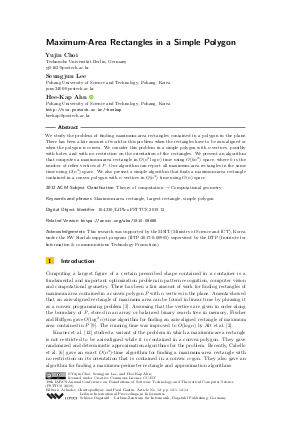Maximum-Area Rectangles in a Simple Polygon
Authors
Yujin Choi,
Seungjun Lee,
Hee-Kap Ahn 
-
Part of:
Volume:
39th IARCS Annual Conference on Foundations of Software Technology and Theoretical Computer Science (FSTTCS 2019)
Part of: Series: Leibniz International Proceedings in Informatics (LIPIcs)
Part of: Conference: IARCS Annual Conference on Foundations of Software Technology and Theoretical Computer Science (FSTTCS) - License:
 Creative Commons Attribution 3.0 Unported license
Creative Commons Attribution 3.0 Unported license
- Publication Date: 2019-12-04
File

PDF
LIPIcs.FSTTCS.2019.12.pdf
- Filesize: 0.64 MB
- 14 pages
Document Identifiers
Related Versions
Subject Classification
ACM Subject Classification
- Theory of computation → Computational geometry
Keywords
- Maximum-area rectangle
- largest rectangle
- simple polygon
Metrics
- Access Statistics
-
Total Accesses (updated on a weekly basis)
0PDF Downloads0Metadata Views
Abstract
We study the problem of finding maximum-area rectangles contained in a polygon in the plane. There has been a fair amount of work for this problem when the rectangles have to be axis-aligned or when the polygon is convex. We consider this problem in a simple polygon with n vertices, possibly with holes, and with no restriction on the orientation of the rectangles. We present an algorithm that computes a maximum-area rectangle in O(n^3 log n) time using O(kn^2) space, where k is the number of reflex vertices of P. Our algorithm can report all maximum-area rectangles in the same time using O(n^3) space. We also present a simple algorithm that finds a maximum-area rectangle contained in a convex polygon with n vertices in O(n^3) time using O(n) space.
Cite As Get BibTex
Yujin Choi, Seungjun Lee, and Hee-Kap Ahn. Maximum-Area Rectangles in a Simple Polygon. In 39th IARCS Annual Conference on Foundations of Software Technology and Theoretical Computer Science (FSTTCS 2019). Leibniz International Proceedings in Informatics (LIPIcs), Volume 150, pp. 12:1-12:14, Schloss Dagstuhl – Leibniz-Zentrum für Informatik (2019)
https://doi.org/10.4230/LIPIcs.FSTTCS.2019.12
BibTex
@InProceedings{choi_et_al:LIPIcs.FSTTCS.2019.12,
author = {Choi, Yujin and Lee, Seungjun and Ahn, Hee-Kap},
title = {{Maximum-Area Rectangles in a Simple Polygon}},
booktitle = {39th IARCS Annual Conference on Foundations of Software Technology and Theoretical Computer Science (FSTTCS 2019)},
pages = {12:1--12:14},
series = {Leibniz International Proceedings in Informatics (LIPIcs)},
ISBN = {978-3-95977-131-3},
ISSN = {1868-8969},
year = {2019},
volume = {150},
editor = {Chattopadhyay, Arkadev and Gastin, Paul},
publisher = {Schloss Dagstuhl -- Leibniz-Zentrum f{\"u}r Informatik},
address = {Dagstuhl, Germany},
URL = {https://drops.dagstuhl.de/entities/document/10.4230/LIPIcs.FSTTCS.2019.12},
URN = {urn:nbn:de:0030-drops-115745},
doi = {10.4230/LIPIcs.FSTTCS.2019.12},
annote = {Keywords: Maximum-area rectangle, largest rectangle, simple polygon}
}
Author Details
Acknowledgements
This research was supported by the MSIT (Ministry of Science and ICT), Korea, under the SW Starlab support program (IITP-2017-0-00905) supervised by the IITP (Institute for Information & communications Technology Promotion).
References
-
Alok Aggarwal and Joel Martin Wein. Computational Geometry Lecture Notes for MIT, 1988.

-
Helmut Alt, David Hsu, and Jack Snoeyink. Computing the Largest Inscribed Isothetic Rectangle. In Proceedings of 7th Canadian Conference on Computational Geometry (CCCG 1995), pages 67-72. University of British Columbia, 1995.

-
Nina Amenta. Bounded Boxes, Hausdorff Distance, and a New Proof of an Interesting Helly-type Theorem. In Proceedings of 10th Annual Symposium on Computational Geometry (SoCG 1994), pages 340-347, 1994.

-
Sang Won Bae, Chunseok Lee, Hee-Kap Ahn, Sunghee Choi, and Kyung-Yong Chwa. Computing minimum-area rectilinear convex hull and L-shape. Computational Geometry, 42(9):903-912, 2009.

-
Ralph P. Boland and Jorge Urrutia. Finding the Largest Axis-Aligned Rectangle in a Polygon in O(nlog n) time. In Proceedings of 13th Canadian Conference on Computational Geometry (CCCG 2001), pages 41-44, 2001.

-
Sergio Cabello, Otfried Cheong, Christian Knauer, and Lena Schlipf. Finding largest rectangles in convex polygons. Computational Geometry, 51:67-74, 2016.

-
Danny Z. Chen and Haitao Wang. Visibility and ray shooting queries in polygonal domains. Computational Geometry, 48(2):31-41, 2015.

-
Karen Daniels, Victor Milenkovic, and Dan Roth. Finding the largest area axis-parallel rectangle in a polygon. Computational Geometry, 7(1):125-148, 1997.

-
Paul Fischer and Klaus-Uwe Höffgen. Computing a maximum axis-aligned rectangle in a convex polygon. Information Processing Letters, 51(4):189-193, 1994.

-
Partha P. Goswami, Sandip Das, and Subhas C. Nandy. Triangular range counting query in 2D and its application in finding k nearest neighbors of a line segment. Computational Geometry, 29(3):163-175, 2004.

-
Olaf Hall-Holt, Matthew J. Katz, Piyush Kumar, Joseph S. B. Mitchell, and Arik Sityon. Finding Large Sticks and Potatoes in Polygons. In Proceedings of 17th Annual ACM-SIAM Symposium on Discrete Algorithm (SODA 2016), pages 474-483, 2006.

-
Christian Knauer, Lena Schlipf, Jens M. Schmidt, and Hans Raj Tiwary. Largest inscribed rectangles in convex polygons. Journal of Discrete Algorithms, 13:78-85, 2012.

-
Michael McKenna, Joseph O'Rourke, and Subhash Suri. Finding the largest rectangle in an orthogonal polygon. In Proceedings of 23rd Allerton Conference on Communication, Control and Computing, pages 486-495, 1985.

-
Derick Wood and Chee K. Yap. The orthogonal convex skull problem. Discrete & Computational Geometry, 3(4):349-365, 1988.

